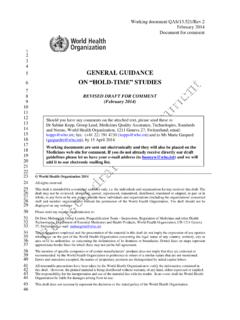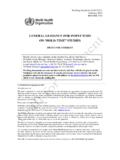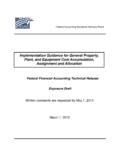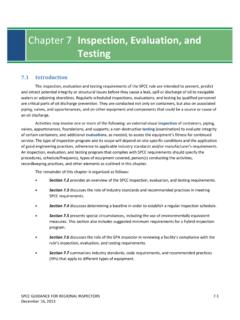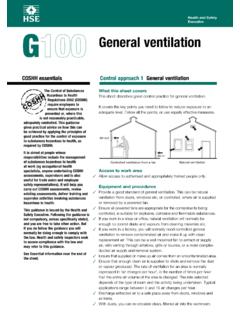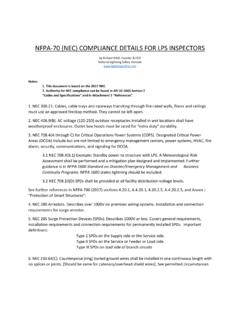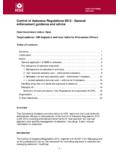Transcription of Core topic 1: Competence assurance - Health and Safety ...
1 core topics core topic 1: Competence assurance Introduction The key issue for sites is to consider the Competence of staff in relation to the control of MAHs and how this is identified, assessed and managed as part of a Competence assurance system. When designing a competency system the sites need to be clear about what part people play in the prevention of major accidents and what part training and competency play in this. MAH competency needs to be appropriately linked to the MAH hazard and risk analysis and key procedures. The aim is to assure Safety critical tasks, and associated roles and responsibilities. Key areas to examine Focus on MA prevention: competency arrangements should not just be aimed at personal Safety issues or one off COMAH training.
2 The site should be clear about the part that people play in the prevention of major accidents and the part that training and competency play in this. Competency for all roles: competency for MA prevention is necessary at all levels of the organisation, not just the front line. Standards: there should be standards set for competency at all levels, and these should be site and process/job specific. NVQ/SVQs: the role and scope of SVQ/NVQs is often not properly understood and operators may assume that completion of generic VQs is sufficient for competency. There will always be gaps at site/process level which need to be addressed by more specific training even for tailored VQs. Procedures: competency and training arrangements need clear links to Safety critical procedures.
3 On-the-job training: this should be as well-structured as the theory/process training and with specific links to MA prevention. Trainees need specific training/learning objectives ( in a training plan) for this. Resourcing: training is often under-resourced and competency may not be seen as an ongoing activity. Foreseeable operational modes: training is required not just for normal operation but also for abnormal/upset, emergency and maintenance conditions. These less frequent events may need more rigorous, training and competency arrangements than for day-to-day operations. Competency includes experience: after formal training staff may be deemed competent , but to become fully competent they need to use the training and to become comfortable and confident with it, what we really mean when we say competent includes adequate experience.
4 Proportionality: assessment of the training needs to be proportionate to the hazards and risks concerned ( by use of adequate testing, passmarks, performance checks) and verification needs to be made. Validation and Evaluation: training also needs to be adequately validated ( Did this training deliver what it was supposed to? ), evaluated ( Is this the right kind of training for our needs? ) and recorded. Trainers and assessors: they need to be trained in their roles, and, equally importantly, they need to be credible (experienced, knowledgeable and with sufficient process understanding) to the workforce. Reassessment and refresher training: arrangements should be in place to check and monitor task performance, reassess Competence in key areas and provide appropriate refresher training.
5 Inspection points: Assess documentation and records. Talk to trainers and assessors, and new employees (operators) or those in training. Focus on Safety critical tasks & key MAH roles. Ask how on-the-job ( process/job-specific) training is structured. Work with existing training department if possible to encourage ownership, ongoing commitment and in-house expertise. Are there standards for competency at all levels, and that are site and process/job-specific? Ask about how range of training needs covered normal, upset, emergency and any use of simulators (for complex plant and upsets). Consider maintenance & technical training. Quality of the trainers. The role of refresher training. Site s auditing themselves on the effectiveness of the training arrangements. Specific documents In addition to the general documents that should be requested prior to the visit (see chapter Aim of the Guidance ) it is recommended that the following documents, which are specific to this topic , should also be requested: Training records for a selection of personnel involved in the control of MAH; Records of audit/review of the competency assurance system.
6 Enforcement and advice The HID approach should focus on ensuring there is a thorough understanding and analysis of the MAH elements of the job and tasks concerned, and that these are linked to training. In general we are looking for evidence that: There is a structured and continuous process in place which is firmly linked to the MAHs on site, and to identified Safety -sensitive roles, responsibilities, tasks and procedures. There are adequate arrangements, resource and commitment in place to maintain Competence . Improvement Notices have been issued on establishing a competency framework during a major business process re-engineering and following a major incident. Guidance Reducing error and influencing behaviour, HSG48. Developing and maintaining staff Competence : railway Safety principles and guidance (part 3 section A) HSG197.
7 Competence assessment for the hazardous industries Research report 086, includes a usable format for sites to use for self assessment of their training and competency arrangements. Question set: Competence assurance Question Site response Inspectors view Improvements needed 1 Is Competence in relation to management of the major hazards approached in a structured manner? 2 Are the training requirements linked to major accident hazards (MAHs) clearly identified? Is the approach to training and competency clearly set out in relation to MAHs? 3 Are Safety -critical roles, responsibilities and tasks clearly identified? Are the Competence standards required to ensure their safe conduct defined? What are the links to Safety critical procedures and tasks?
8 Is training clearly linked to these? Are all levels of staff included (including managers)? 4 Is the Competence of those managing thecompetence management system maintained? 5 Are trainers - including training managers trained ( train the trainer courses)? Are there assessors appointed and trained? Are trainers and assessors credible? Is the system documented and controlled? Is there verification of the system (internal and external)? 6 Are staff recruited and selected against defined criteria for the job? Question Site response Inspectors view Improvements needed 7 Are all relevant staff trained and assessed against the defined criteria by appropriate means? Is there evidence that training is designed appropriately?
9 Is this training supplemented as required when roles or plant / processes are changed? Is on-the-job training structured, training plans and objectives, testing knowledge etc? If SVQ/NVQs are used, do management understand the scope and limitations of these? Are they generic or tailored? If tailored, are they tailored to the site or more widely? Is on-the-job training structured along similar lines to the VQs? What confidence do staff have in VQs and on-the-job arrangements? 8 Are staff and contractors only asked to undertake work for which they are competent or, when learning, under adequate supervision? 9 Is the Competence of staff monitored and reassessed at suitable intervals to ensure performance is consistently maintained?
10 Are infrequently performed and critical tasks, roles and responsibilities targeted? 10 Is there a suitable record system that candemonstrate competency? Records for each person? Evidence of appropriate validation? Evidence of training AND assessment? 11 Is the system for managing Competence periodically audited and reviewed?










